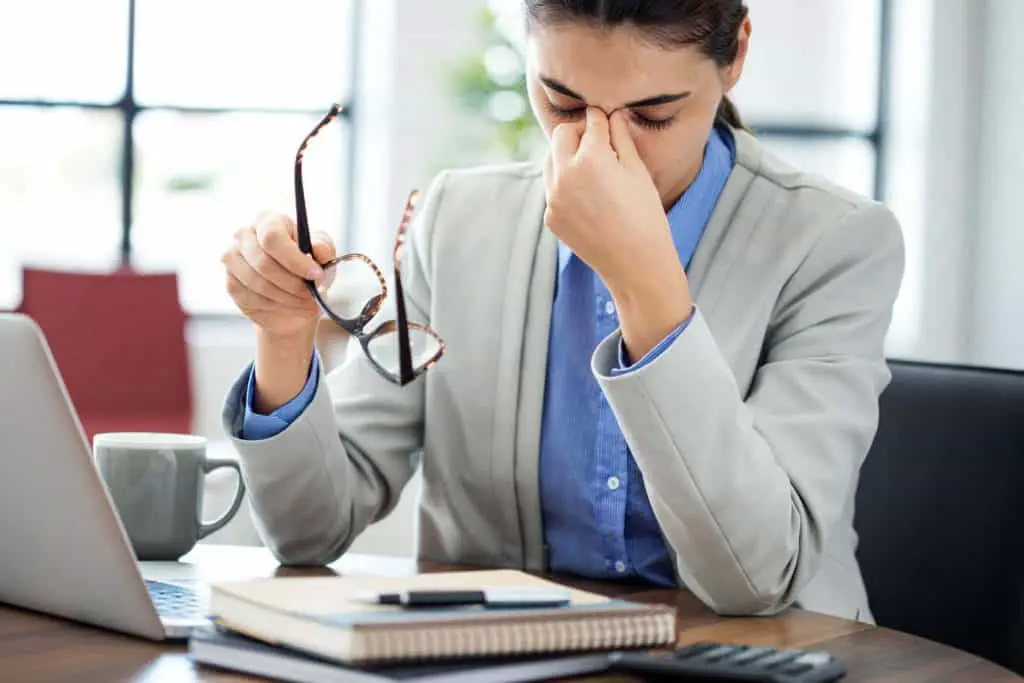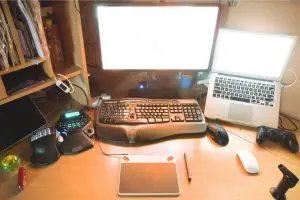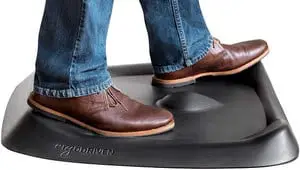Over the past decade, the rapid advance of technology has forced many of us to spend a considerable amount of time in front of a screen. If you are not staring at your smartphones, you are sitting in front of a computer — just like how you’re reading this article right now.
Recent studies have shown that the majority of office workers have eye strain or associated health issues such as eye-twitching, red eyes, headaches, and fatigue. Because this is a serious issue, we need to answer the question: how to help relieve eye strain?
In this post, we will dive deeper into how you can better equip yourself against the demand for the modern working lifestyle.
At Office Solution Pro, we are passionate about Ergonomics! Our readers support the page. If you click on a link, we may earn a small commission at no cost to you. We hope you love the products we recommend as much as we do!
Complications of Eye Strain
When you constantly engage with digital screens over prolonged periods of time, you expose yourself to blue light. Nowadays, everyone is exposed daily to this through harmful sources like computers, laptops, and smartphones. This has numerous negative effects on your eyes in the long term, such as:
- Problems with your retina
- Cataracts
- Sleeping disorders and disturbances
- Age-related degeneration
Unfortunately, you cannot just stop using all forms of electronics as of right now — that would be downright silly! So, to combat this tricky problem, here are some of the things you can do to help reduce eye strain.
Get a Complete Eye Exam
Having a yearly complete eye exam is arguably the most important thing you can do to detect and prevent problems before they develop. During the test, it’s a good idea to tell your doctor about how you work in the office, particularly how often you spend time in front of digital screens.
Prior to seeing your doctor, we advise you to measure how far your eyes are from your screen when you work. Bring the measurement so that your eye doctor will be able to test your eyes at your specific working distance.
Adjust Your Workstation
1. Use Proper Lighting
Excessive bright light — either from outdoor sunlight or from bad interior lighting — is one of the biggest causes of eye strain. You can use shades and blackout curtains to reduce incoming sunlight from office windows. You can also use lower-intensity light bulbs.
If you are not able to change the lighting in your office, the best thing you can do is adjust your computer or laptop position. The best position for your desk is to position them beside a window so that your screen is not in front of or behind the source of light.
If you are someone who wears glasses, we recommend getting lenses with anti-reflective coatings. You can also get special blue light-blocking glasses designed specifically to prevent digital eye strain. This will reduce the exposure to glare by minimizing the quantity of light from reflections.
2. Your Computer Display Settings
Adjusting your screen settings is very important because our retina contains blue-light-sensitive molecules. It has been well-documented that constant exposure to blue light can be detrimental to your eye health.
There are plenty of ways to make your computer and phone screens more eye-friendly, such as making the text larger, increasing your device’s refresh rate to ensure less flickering, and changing your screen color from blue to yellow.
We recommend installing a blue-light filter that adjusts your screen display settings in accordance with your sleep cycle like this one.
3. Adjust Your Position
You will have a harder time focusing if your screen is closer to your eyes. Your screen should be no closer than 16 inches or 40 centimeters away from your face.
To make sure that your workstation can fit your body type accordingly, make sure to adjust your office chair, desk, as well as your keyboard position to maintain a neutral body posture.
Poor posture can lead to computer vision syndrome. Adjust your chair and workstation to the correct height of your body. The right ergonomic set-up should allow you to sit naturally without hindering you when reaching for your desk and your screen.

Blink Often
Blinking is very important as it moistens your eyes to prevent irritation and dryness. You may not realize it, but your eyes blink less frequently when you are staring at your computer or phone screen.
Humans blink at a normal rate of fifteen blinks per minute, but this number drops to about five when looking at screens. According to studies, the blinks performed during computer work are only partial lid closures — meaning that your lid does not close completely.
Because tears evaporate very quickly, it’s common for most people to experience dry eyes as a result of extensive screen use. To reduce the risk of dry eyes, we recommend blinking ten times slowly, as if you are falling asleep, once every twenty minutes. This will ensure your eyes are moist and well-lubricated.

Take Frequent Breaks
Working longer does not mean being productive. It’s important to take regular breaks, not only is it important to rehydrate your eyes but also to ensure that your body is not stiff because of long periods of sitting.
Due to the demands of modern office work, many of us are forced to stay inactive and sit around all day. However, the human body is not designed to only sit around.
Once every hour, it’s important to stand up, move, and stretch to get the blood flowing. We have made a comprehensive guide to maximize your productivity and increase energy by doing unique ergonomic stretches in the office for you.
The 20-20-20 Rule
Long periods of continuous screen-starring can cause your eyes to fatigue, mainly because this action forces your eyes to focus and zoom in on smaller text. A great way to avoid this is to implement the “20-20-20 rule”.
Look away from your computer screen every 20 minutes, and gaze at a distant object 20 feet away for at least 20 seconds. This is a great way to help relax the focusing muscle inside your eyes.
Final Takeaways
Because digital devices and screens are here to stay, maintaining your eye health is the key to reducing serious vision problems in the future. Getting annual check-ups is important, especially if you are exposed to computer screens extensively.
There are many simple habits that you can start to ensure your eyes remain in top shape. If you have headaches or eye fatigue, consider implementing the tips we have shared above to help reduce eye strain.
Having good eye health will ensure that you can enjoy your working days and live life to the fullest! 🙂







